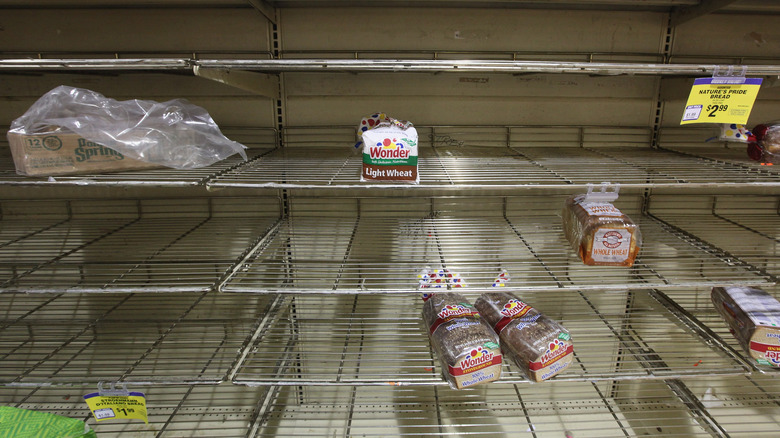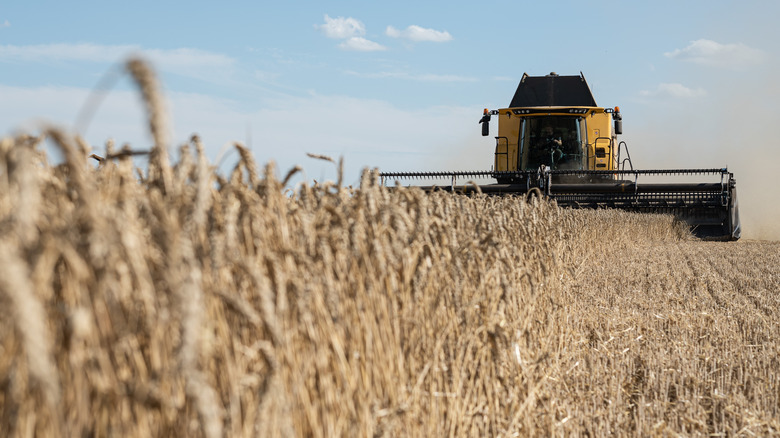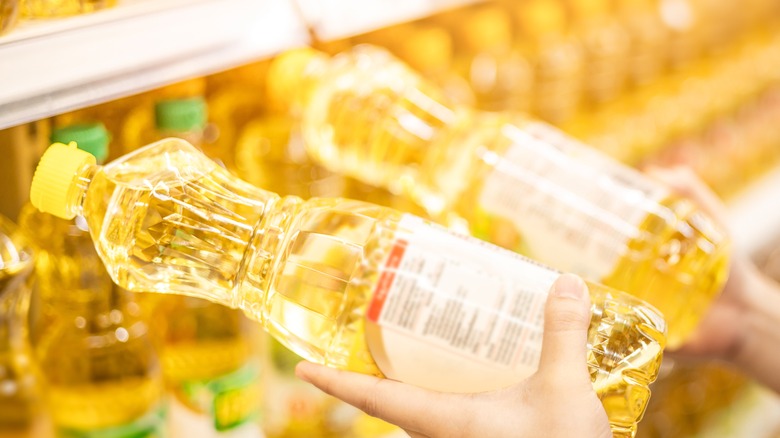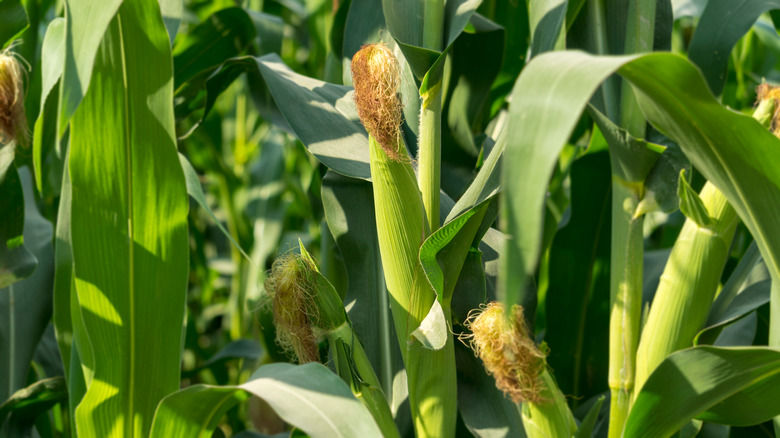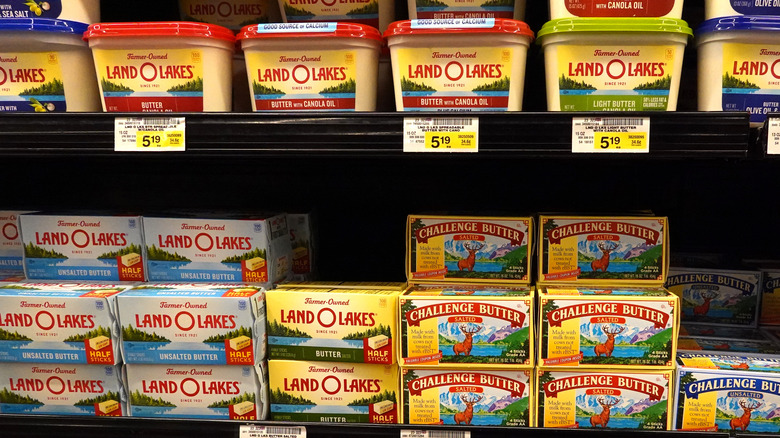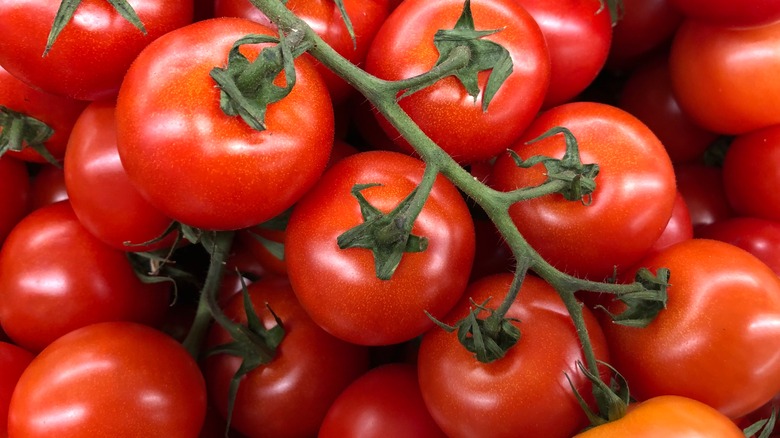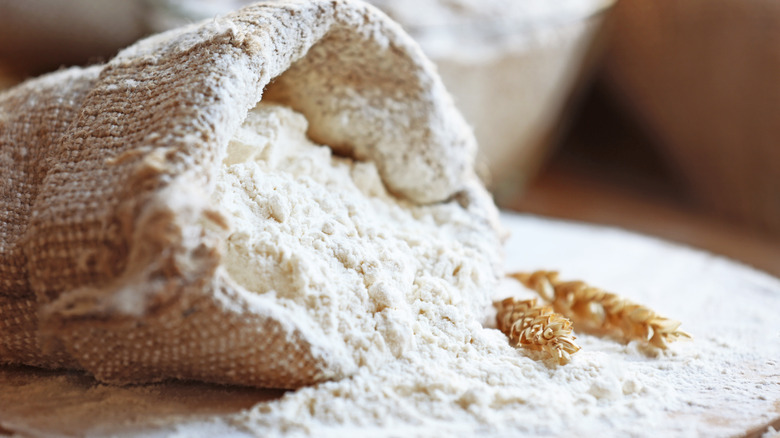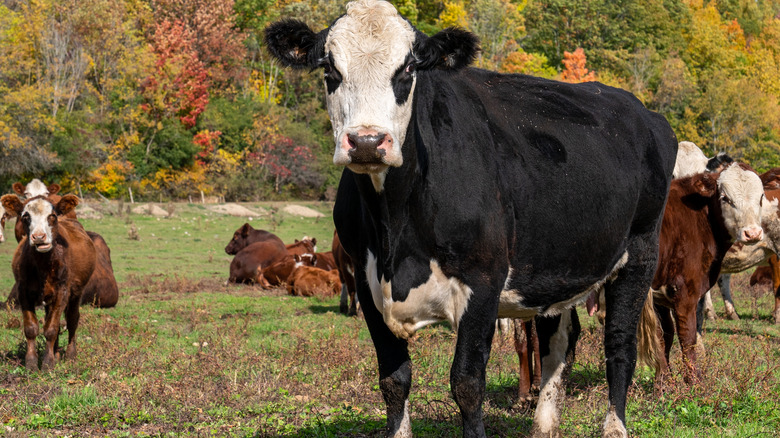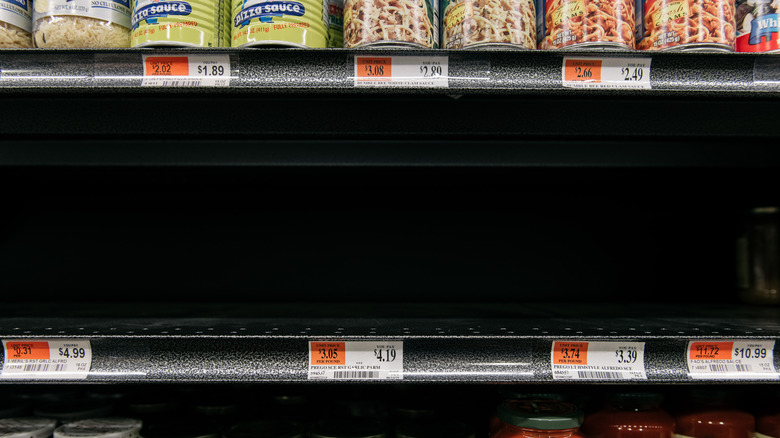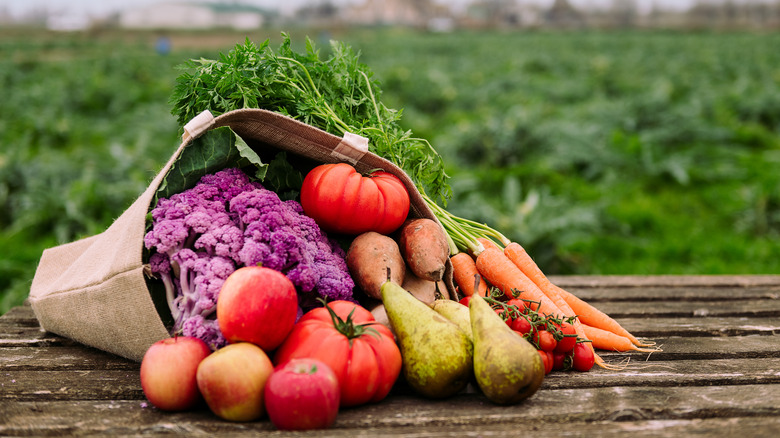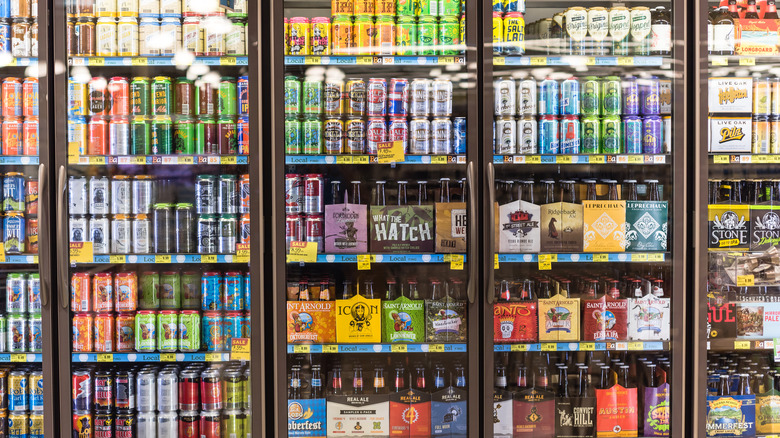Food Shortages That May Happen In 2023
In a lot of ways, modern U.S. consumers are spectacularly spoiled. We don't mean to be critical, since the ability to obtain virtually anything you want at any time is fairly great. But the widespread, constant availability of so many products and services has led to an expectation that those items will always be available. As a result, even a minor inconvenience can lead to stress and panic sometimes — particularly when it comes to our food.
Food shortages have always been an unfortunate part of life. But before the toilet paper shortage that coincided with the start of the COVID-19 pandemic in March 2020, many U.S. citizens had been spared from any seemingly random occurrences of sparsely stocked shelves. Of course, two-plus years later, the presence of shortages at the supermarket has become much more common. And between the lingering pandemic, worsening climate change, and the ongoing war between Russia and Ukraine, which began in February 2022, anyone hoping for a reprieve from food shortages in 2023 shouldn't hold their breath.
We'd love nothing more than to declare that bountiful (and affordable) food products await us in 2023. But the reality of the global situation dictates pragmatism rather than heedless optimism. While there's no guarantee any potential issues will come to pass, the available evidence provides clues on what to expect. With that in mind, here's what we know about the food shortages that may happen in 2023.
Bread
Few food products embody the essence of staple items like bread. There's a reason why Massachusetts residents routinely stock up on bread and milk before a Nor'easter winter storm, after all (via Patch). But with no end in sight to the 2022 Russia-Ukraine war — between two nations that account for nearly 20% of global cereal grain production (via Brookings Institution) — many bakeries and factories may struggle to obtain the necessary ingredients to make bread, leading to a potential shortage in 2023.
Many bakeries across the U.S. were already feeling the strain of dwindling bread-making supplies by May 2022, according to CBS News. Consequently, the basic economic principles of supply and demand (in which greater demand amid lower supply leads to a higher cost for consumers) has already led to a nationwide increase in the price of bread.
The diminished stock of basic components for bread production isn't likely to replenish before the new year, given the continued conflict in Eastern Europe. An agreement between Ukraine and Russia did allow the export of agricultural products from the Black Sea to resume in July 2022 (via Business Insider). But as long as the war persists, cereal grain production in the region will continue to suffer — with bread availability in 2023 a likely casualty.
Vegetable oil
Is there any reason why the average person would need to know how and where vegetable oil is made? Sure, the fact that it's generally made with oilseed crops, such as soybeans, sunflowers, and canola, is somewhat interesting, but it's far from essential knowledge. However, knowing a large portion of those oilseeds are grown and harvested in Ukraine and Russia — including more than 70% of the global sunflower seed and oil production in 2020 (via Brookings Institution) — will at least help you understand why a potential vegetable oil shortage is likely in 2023.
Given the area's outsized global contribution, the Russia-Ukraine conflict may substantially reduce the availability of sunflower oilseed products, including vegetable oils derived from the crop, for the foreseeable future. But the chance of a 2023 vegetable oil shortage isn't solely related to Ukraine or Russia. A concurrent palm oil shortage in Indonesia, which briefly banned the export of palm oil in April 2022, hasn't helped matters (via Agri-Pulse). Since Indonesia is the world's leading producer of palm oil, any ongoing supply issues only compound the potential problem of vegetable oil availability in 2023.
Maybe you've never pondered the origin of many foods you consume — vegetable oil chief among them. But as the old Cinderella song goes, you "Don't Know What You Got (Till It's Gone)." So if a vegetable oil shortage happens in 2023, perhaps a wider curiosity about oilseeds will emerge.
Corn
We don't mean to be corny here, but corn holds a special place in our hearts. The monumentally versatile food item may be categorized at different times as a vegetable, grain, or fruit, according to Healthline. Yet regardless of the format corn is virtually guaranteed to deliver an exquisitely delightful experience when consuming it. And considering our adoration for all things corn, we were immensely disheartened to discover that less corn was planted in 2022 than the year before, according to USDA. A smaller batch of planted crops means a smaller overall yield — which could potentially lead to a corn shortage in 2023. The smaller batch of corn crops doesn't necessarily guarantee that corn-based products will disappear from shelves next year. But, as one agricultural investor told Successful Farming in May 2022, the reduced corn harvest does unfortunately mean "the world will be facing relatively high food prices for an extended period."
On a more optimistic note, agricultural policy experts at the University of Missouri published a 2022 study predicting the price of corn will eventually fall. However, the analysis does little to help consumers in 2023, as the overall drop in cost isn't expected to occur until 2024 at the earliest.
Butter
We don't mean to rain on the parade of any "Funny Girl" fans out there, but the sun is not actually a ball of butter. If only it were, though. That would help tremendously with the looming butter shortage predicted for the 2022 holiday baking season. Of course, clarifying a metaphorical song lyric doesn't lessen the larger concern regarding a butter shortage at the end of 2022 — mainly, that it could extend into 2023.
Amidst crushing inflation levels in 2022, you may have already noticed the rising price of butter at your local grocery store. This isn't by chance. After all, between lower-than-expected milk production at many U.S. dairy farms, and a sustained labor shortage at many of those same farms, the stock of cold-stored butter has diminished to its lowest level since 2017, according to The Wall Street Journal.
A slight increase in the overall milk production for 2023 is expected, according to Farmers Advance, which will help replenish butter stocks as the year progresses. But while the expected supply should be greater than in 2022, the expected 2023 price for butter is still 65 cents higher than in 2021 — suggesting that stores will remain somewhat depleted. Additionally, since the supply issues this holiday season are likely to extend into the very early part of next year, the best course of action may be to prepare for a butter shortage for at least part of 2023.
Hershey candy
If you were hoping the Halloween and Christmas candy shortage that Hershey's anticipated in 2022 would end when the holidays do, we can't say we're as optimistic. Sure, the chocolate company claims it has taken steps to overcome the low supply of candy offerings it expects this holiday season, and has assured the public the problems won't linger. But since the main forces behind the supply chain issues leading to ingredient scarcity haven't been entirely resolved — namely, the COVID-19 pandemic, and the Russia-Ukraine war — we're planning for a potential Hershey candy shortage around the holidays in 2023 as well.
Hershey told Food Dive in August 2022 that it did, in fact, anticipate the holiday candy shortage would be resolved moving forward. So our pessimistic prediction regarding a potential problem in 2023 may be a bit harsh. But we're still leery of taking the company's word on the matter ... and we'd much rather be safe than sorry, especially as Hershey notes that consumer demand for its candy has continued to increase in recent years.
At least the holiday candy shortage seems to be an exclusively Hershey problem, rather than an industry-wide concern. Frankly, there's some solace to be found knowing we don't need to worry about holiday shortages of M&M's or Butterfingers.
Champagne
Champagne connoisseurs may be aghast to see it listed among potential food shortages for 2023. After all, there already is an ongoing shortage of champagne throughout the world, one which began during the early stages of the COVID-19 pandemic, according to Wine Enthusiast. We certainly wish we could say otherwise, but the chances of champagne — as in real champagne, from the Champagne region in France — remaining sparse in 2023 are more likely than not.
The strict regulation of champagne production in France, which is overseen by the Comité Interprofessionnel du Vin de Champagne (CIVC), doesn't help the cause. After all, the trade organization puts a cap on how much champagne can be produced each year, which included a 25% reduction in total production in 2020 (compared to 2019) after the start of the pandemic (via Wine Enthusiast). Given the time and effort involved in producing authentic champagne, the CIVC's reduction mandate in 2020 continues to stifle U.S. availability.
It isn't just the 2020 CIVC decision that's created a problem, though, as climate change also reared its ugly head towards Champagne grapes in 2021. A rash of extreme weather that year resulted in a devastating number of crops growing fungus, leading to a smaller than average crop yield (via Reuters). While vineyard owners were optimistic about 2022's grape potential, the backlog of issues related to champagne's shortage means it's unlikely the bubbly beverage will be overflowing any time soon.
Tomatoes
California is responsible for an almost incomprehensible amount of U.S. produce. In fact, according to the California Department of Food and Agriculture, in 2021 more than a third of U.S. vegetables were grown in the state, along with 75% of the nation's fruits and nuts. Consequently, a drought there is apt to have a disproportionate effect on the rest of the nation's food supply. In other words, if we find ourselves amidst a tomato shortage in 2023, blame the extended drought devastating California (via Fox Business).
It's not exactly mind blowing that a state currently experiencing the driest three-year stretch in its recorded history has found its farm industry severely impacted (via Los Angeles Times). Frankly, given the sustained period of excessive dryness in the Golden State — where more than half the state remains in extreme or exceptional drought as of October 2022, per U.S. Drought Monitor – the odds of a tomato shortage in 2023 are sky-high.
Since tomatoes are a base ingredient in numerous popular dishes and food items, the concern about a potential tomato shortage in 2023 can't be overstated. Thankfully (for some), as a spokesperson for Kraft Heinz told Fox Business in October 2022, the food company didn't anticipate any issues with its production of ketchup, or other tomato-centric products, in the near future.
Flour
No ingredient is more crucial to bread dough than flour. This staple ingredients is made from cereal grains, most often wheat (via Institute of Culinary Education). Since nearly one-fifth of the world's cereal grain is grown in Ukraine and Russia (via Brookings Institution) — where a war continues raging as of October 2022 – it's only natural to conclude a flour shortage may be coming in 2023. But it's not just the conflict between Ukraine and Russia that's inching the world towards a flour shortage. The increasingly detrimental impact of climate change may led to a reduction in wheat crop yields as well, as it has done in the past (via The Conversation). This could only serve to lower the amount of available flour in 2023 and beyond.
Since flour isn't used solely in bread production, it merits inclusion on this list as its own individual item. Because, frankly, the fallout from a flour shortage wouldn't be limited to a lack of available bread — it would cause a potential reduction in all baked goods.
Beef
It's important to remember that a shortage of a particular food doesn't automatically mean that food won't be available for purchase. Many times, consumers will notice a shortage upon experiencing sticker shock at their local supermarket. Unfortunately, the widespread instances of skyrocketing prices on basic food items isn't likely to change much in 2023, particularly when it comes to beef. And with a fairly stark drop in beef production predicted in the second half of this year, you can expect a batch of burgers or steaks to dent your wallet soon (via USDA).
Of all the potential food shortages that may happen in 2023, a beef shortage may be the easiest to predict. Industry insiders were already anticipating a price increase of at least 15% on beef back in September 2022, according to Restaurant Dive, after a drought forced many farmers to sell off their cattle earlier than anticipated this year. Consequently, some farmers were forced to sell female cows before they were able to birth a new baby, as ranch owner Wesley Ratcliff told Reuters, which will inevitably reduce the number of available cows for slaughter in the near future until the herds can be replenished over time.
Folks with carnivorous cravings may be unable to satiate their desires as easily with beef in 2023. But if nothing else, domestic production of pork, chicken, and turkey rose during 2022. So even if a shortage of beef is on the table, a forced shift to vegetarianism is not.
Aluminum canned goods
An absence of abundantly available raw materials generally portends the shortage of a specific type of processed food. But what if the items needed to craft the actual container that holds a food product are lacking? Well, you may find out in 2023. Consumers could be facing a shortage of several food and beverage products typically packaged and sold in aluminum cans due to an ongoing, worldwide aluminum shortage in 2022 caused by a major increase in demand (via ClickOrlando.com).
Now, if there's a silver lining to be had when it comes to the aluminum shortage, it's the fact that fairly few food items are still packed in aluminum cans these days. According to Scientific American, many modern food cans are actually composed of steel. However, a lot of beverages, including beer and soda, are typically still made with aluminum. And potential shortage of canned drinks is nothing to sneeze at. Additionally, since aluminum is still often used as a laminate lining for many canned food products (via Institute of Food Technologies), it's better to prepare for a potential shortage of certain aluminum canned foods in 2023 than to not.
Farm-grown produce
While this list has already highlighted certain specific fruits and vegetables that may face a potential shortage in 2023, the sad truth is that others may join them on the sideline, as well. After all, between climate change, and a worldwide fertilizer shortage (via Business Insider), there's a better than average chance that we face a shortage of any — if not all — farm-grown fruits and vegetables in 2023.
The culprit for the world's severe lack of fertilizer, like many other potential supply shortage issues facing us in 2023, is easy to identify — the Ukraine-Russia war. After all, since Russia is one of the world's largest producers of all three main fertilizer types (nitrogen, potassium, and phosphorus), its current preoccupation with a military conflict has diminished its export of fertilizers. In fact, the cost of fertilizer jumped 50% after Russia invaded Ukraine, only further exacerbating the problem (via Politico).
It isn't just a fertilizer shortage that took a negative toll on farm-grown produce, though. In particular, in the western U.S., a continuous drought has resulted in substantially fewer crops grown than expected, lowering the future supply of tomatoes, onions, and garlic, among others, reports Fox Business.
Beer
Clearly, we don't anticipate much relief when it comes to food shortages in 2023. But at least you can always drink away your sorrows with a nice, frosty beer, right? Well, if that's your plan ... please don't blame the messenger. Because while a desire to grab an ice cold brewski in 2023 would be understandable, the cruel irony is that a beer shortage may be in the cards, too. According to ClickOrlando.com, the current aluminum shortage could decrease can production, while a lack of available carbon dioxide may impact production of the beverage itself (via Axios).
Since most beverage cans in the U.S. are made with aluminum (via Scientific American), the potential impact on a brewery's ability to pack and sell its beer in cans is clear to see. But more than just a lack of material to make cans, an impending 2023 beer shortage is due to the decreased supply of carbon dioxide — an issue that's already caused some smaller craft breweries to shift their production process as of September 2022, according to NPR.
Like many other food shortages we anxiously await in 2023, we don't expect to see beer totally stripped from liquor store shelves next year. But consumers who've grown accustomed to choosing from dozens of small craft beer options in recent years may be forced to settle for mass-produced options instead.
